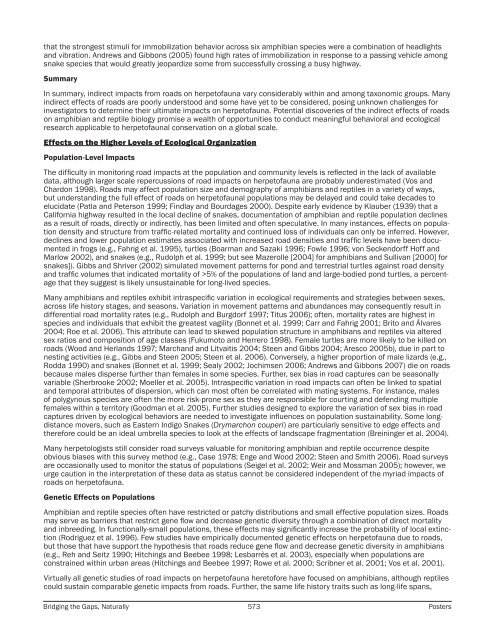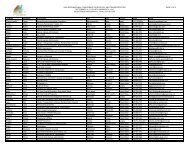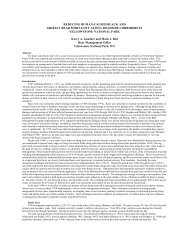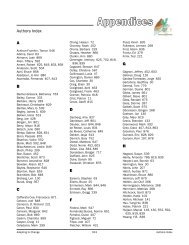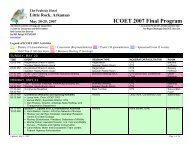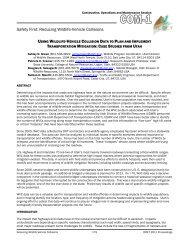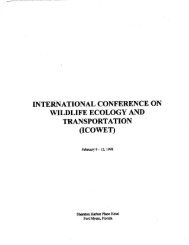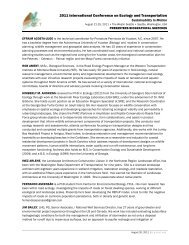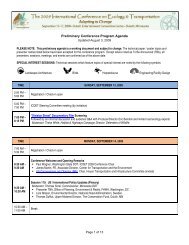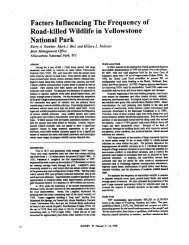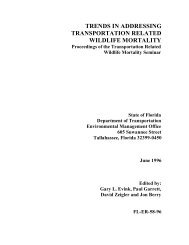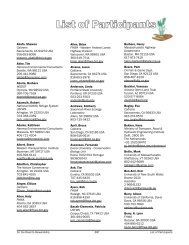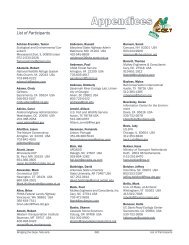Poster Sessions, pages 567-640 - ICOET
Poster Sessions, pages 567-640 - ICOET
Poster Sessions, pages 567-640 - ICOET
Create successful ePaper yourself
Turn your PDF publications into a flip-book with our unique Google optimized e-Paper software.
that the strongest stimuli for immobilization behavior across six amphibian species were a combination of headlights<br />
and vibration. Andrews and Gibbons (2005) found high rates of immobilization in response to a passing vehicle among<br />
snake species that would greatly jeopardize some from successfully crossing a busy highway.<br />
Summary<br />
In summary, indirect impacts from roads on herpetofauna vary considerably within and among taxonomic groups. Many<br />
indirect effects of roads are poorly understood and some have yet to be considered, posing unknown challenges for<br />
investigators to determine their ultimate impacts on herpetofauna. Potential discoveries of the indirect effects of roads<br />
on amphibian and reptile biology promise a wealth of opportunities to conduct meaningful behavioral and ecological<br />
research applicable to herpetofaunal conservation on a global scale.<br />
Effects on the Higher Levels of Ecological Organization<br />
Population-Level Impacts<br />
The difficulty in monitoring road impacts at the population and community levels is reflected in the lack of available<br />
data, although larger scale repercussions of road impacts on herpetofauna are probably underestimated (Vos and<br />
Chardon 1998). Roads may affect population size and demography of amphibians and reptiles in a variety of ways,<br />
but understanding the full effect of roads on herpetofaunal populations may be delayed and could take decades to<br />
elucidate (Patla and Peterson 1999; Findlay and Bourdages 2000). Despite early evidence by Klauber (1939) that a<br />
California highway resulted in the local decline of snakes, documentation of amphibian and reptile population declines<br />
as a result of roads, directly or indirectly, has been limited and often speculative. In many instances, effects on population<br />
density and structure from traffic-related mortality and continued loss of individuals can only be inferred. However,<br />
declines and lower population estimates associated with increased road densities and traffic levels have been documented<br />
in frogs (e.g., Fahrig et al. 1995), turtles (Boarman and Sazaki 1996; Fowle 1996; von Seckendorff Hoff and<br />
Marlow 2002), and snakes (e.g., Rudolph et al. 1999; but see Mazerolle [2004] for amphibians and Sullivan [2000] for<br />
snakes]). Gibbs and Shriver (2002) simulated movement patterns for pond and terrestrial turtles against road density<br />
and traffic volumes that indicated mortality of >5% of the populations of land and large-bodied pond turtles, a percentage<br />
that they suggest is likely unsustainable for long-lived species.<br />
Many amphibians and reptiles exhibit intraspecific variation in ecological requirements and strategies between sexes,<br />
across life history stages, and seasons. Variation in movement patterns and abundances may consequently result in<br />
differential road mortality rates (e.g., Rudolph and Burgdorf 1997; Titus 2006); often, mortality rates are highest in<br />
species and individuals that exhibit the greatest vagility (Bonnet et al. 1999; Carr and Fahrig 2001; Brito and Álvares<br />
2004; Roe et al. 2006). This attribute can lead to skewed population structure in amphibians and reptiles via altered<br />
sex ratios and composition of age classes (Fukumoto and Herrero 1998). Female turtles are more likely to be killed on<br />
roads (Wood and Herlands 1997; Marchand and Litvaitis 2004; Steen and Gibbs 2004; Aresco 2005b), due in part to<br />
nesting activities (e.g., Gibbs and Steen 2005; Steen et al. 2006). Conversely, a higher proportion of male lizards (e.g.,<br />
Rodda 1990) and snakes (Bonnet et al. 1999; Sealy 2002; Jochimsen 2006; Andrews and Gibbons 2007) die on roads<br />
because males disperse further than females in some species. Further, sex bias in road captures can be seasonally<br />
variable (Sherbrooke 2002; Moeller et al. 2005). Intraspecific variation in road impacts can often be linked to spatial<br />
and temporal attributes of dispersion, which can most often be correlated with mating systems. For instance, males<br />
of polygynous species are often the more risk-prone sex as they are responsible for courting and defending multiple<br />
females within a territory (Goodman et al. 2005). Further studies designed to explore the variation of sex bias in road<br />
captures driven by ecological behaviors are needed to investigate influences on population sustainability. Some longdistance<br />
movers, such as Eastern Indigo Snakes (Drymarchon couperi) are particularly sensitive to edge effects and<br />
therefore could be an ideal umbrella species to look at the effects of landscape fragmentation (Breininger et al. 2004).<br />
Many herpetologists still consider road surveys valuable for monitoring amphibian and reptile occurrence despite<br />
obvious biases with this survey method (e.g., Case 1978; Enge and Wood 2002; Steen and Smith 2006). Road surveys<br />
are occasionally used to monitor the status of populations (Seigel et al. 2002; Weir and Mossman 2005); however, we<br />
urge caution in the interpretation of these data as status cannot be considered independent of the myriad impacts of<br />
roads on herpetofauna.<br />
Genetic Effects on Populations<br />
Amphibian and reptile species often have restricted or patchy distributions and small effective population sizes. Roads<br />
may serve as barriers that restrict gene flow and decrease genetic diversity through a combination of direct mortality<br />
and inbreeding. In functionally-small populations, these effects may significantly increase the probability of local extinction<br />
(Rodriguez et al. 1996). Few studies have empirically documented genetic effects on herpetofauna due to roads,<br />
but those that have support the hypothesis that roads reduce gene flow and decrease genetic diversity in amphibians<br />
(e.g., Reh and Seitz 1990; Hitchings and Beebee 1998; Lesbarrès et al. 2003), especially when populations are<br />
constrained within urban areas (Hitchings and Beebee 1997; Rowe et al. 2000; Scribner et al. 2001; Vos et al. 2001).<br />
Virtually all genetic studies of road impacts on herpetofauna heretofore have focused on amphibians, although reptiles<br />
could sustain comparable genetic impacts from roads. Further, the same life history traits such as long-life spans,<br />
Bridging the Gaps, Naturally 573 <strong>Poster</strong>s


